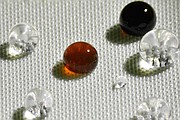SAFETY IN WATER REPELLENCY
Water-Repellent Textile Coating Promotes Safer Manufacturing Practices
When trying to meet the demand for green apparel, manufacturers are often faced with the challenge of creating comparable eco-friendly alternatives to match the performance of products that have been identified as harmful to the environment or human health. This performance challenge is particularly true of naturally sourced textiles that are used to make water-resistant apparel.
According to Kripa Varanasi, who is an associate professor of mechanical engineering at the Massachusetts Institute of Technology (MIT), many textiles that claim to offer water-repellent properties by their manufacturers don’t meet the standards they claim.
“Most fabrics that say ‘water-repellent’ are actually water-resistant,” Varanasi said in a statement. “If you’re standing out in the rain, eventually water will get through. Ultimately, the goal is to be repellent—to have the drops just bounce back.”
In their paper, “Short-Fluorinated iCVD Coatings for Nonwetting Fabrics,” published in the scientific journal Advanced Functional Materials, Varanasi, MIT professor Karen Gleason, former MIT post-doctorate affiliate Dan Soto, researcher Asli Ugur and laboratory assistant Taylor Farnham identified an alternative process to render textiles water repellent, or hydrophobic. Through its research, the team introduced a new type of coating to replace the potentially harmful chemicals often used to manufacture water-repellent textiles.
Citing the potential threats of perfluorooctane sulfonate (PFOS) and perfluorooctanoic acid (PFOA), which are classified as long perfluorinated side-chains polymers, the MIT scientists set out to find less-harmful methods for protecting textiles from liquids. These commonly used chemicals can remain in the environment and human body over long periods of time and have been restricted in the United States.
While the chemicals are not made in the United States, according to the Environmental Protection Agency, apparel and textiles manufactured with these substances are imported into the country. The EPA is aware of the threats surrounding the chemicals and continues to investigate their detrimental effects.
In November 2017, California’s Office of Environmental Health Hazard Assessment (OEHHA) formally recognized PFOA and PFOS as potentially harmful and added them to its Proposition 65 list of substances that could cause reproductive toxicity.
By using a method known as iCVD, or initiated chemical vapor deposition, the scientists applied durable, conformal short fluorinated polymers stabilized with a cross-linking agent to fabrics including cotton, silk, linen and wool that featured different weaves, such as duchesse, luxury duchesse, georgette and plain. These shorter polymers do not pose as great a threat as their longer counterparts, nor do they remain in the environment or bioaccumulate in the human body.
This iCVD process also solves another issue faced when manufacturing water-repellent clothing by traditional methods. Manufacturing through the current standards requires a liquid-based coating that is created by immersing fabric in the solution, a process that typically impedes the breathability of the textile due to pores blocked by the liquid as it dries. To afford greater airflow through the fabric, air is forced through the small holes in the material, creating an additional manufacturing step and compromising the water-repellent properties.
“The biggest challenge was finding the sweet spot where performance, durability and iCVD compatibility could work together and deliver the best performance,” Soto explained in a press release.
The iCVD method bypasses the use of liquids in favor of the application of a coating that is thin, uniform and can be performed in an environment of low temperature. Using this process allows a textile’s breathability to remain unhindered, which would enable manufacturers to omit the task of clearing the pores.
In addition to testing water repellence of the coated textiles through an industry-standard rain test, Varanasi revealed that experimenting with coating also included exposing the materials to an array of fluids, such as coffee, ketchup, sodium hydroxide, and acids and bases. While the coating withstood exposure to these liquids, the team also wanted to explore how the textiles would fare over time after multiple wash cycles.
After discovering that repeatedly washing the materials wouldn’t break down the coating, the team conducted abrasion tests through 10,000 repetitions, which subjected the protective layer to severe conditions. Upon examination of the fabric following this test, no damage to the coating could be found.
“Many fabrics can benefit from this technology,” Varanasi said. “There’s a lot of potential here.”























